Library Management System Design - Desklib
VerifiedAdded on 2022/11/14
|9
|2351
|394
AI Summary
This article discusses the design and development of a library management system, including project aims and objectives, supported operations, algorithms, and changes needed for larger universities. It also covers variables, project keys, and the distinction between users and admins.
Contribute Materials
Your contribution can guide someone’s learning journey. Share your
documents today.
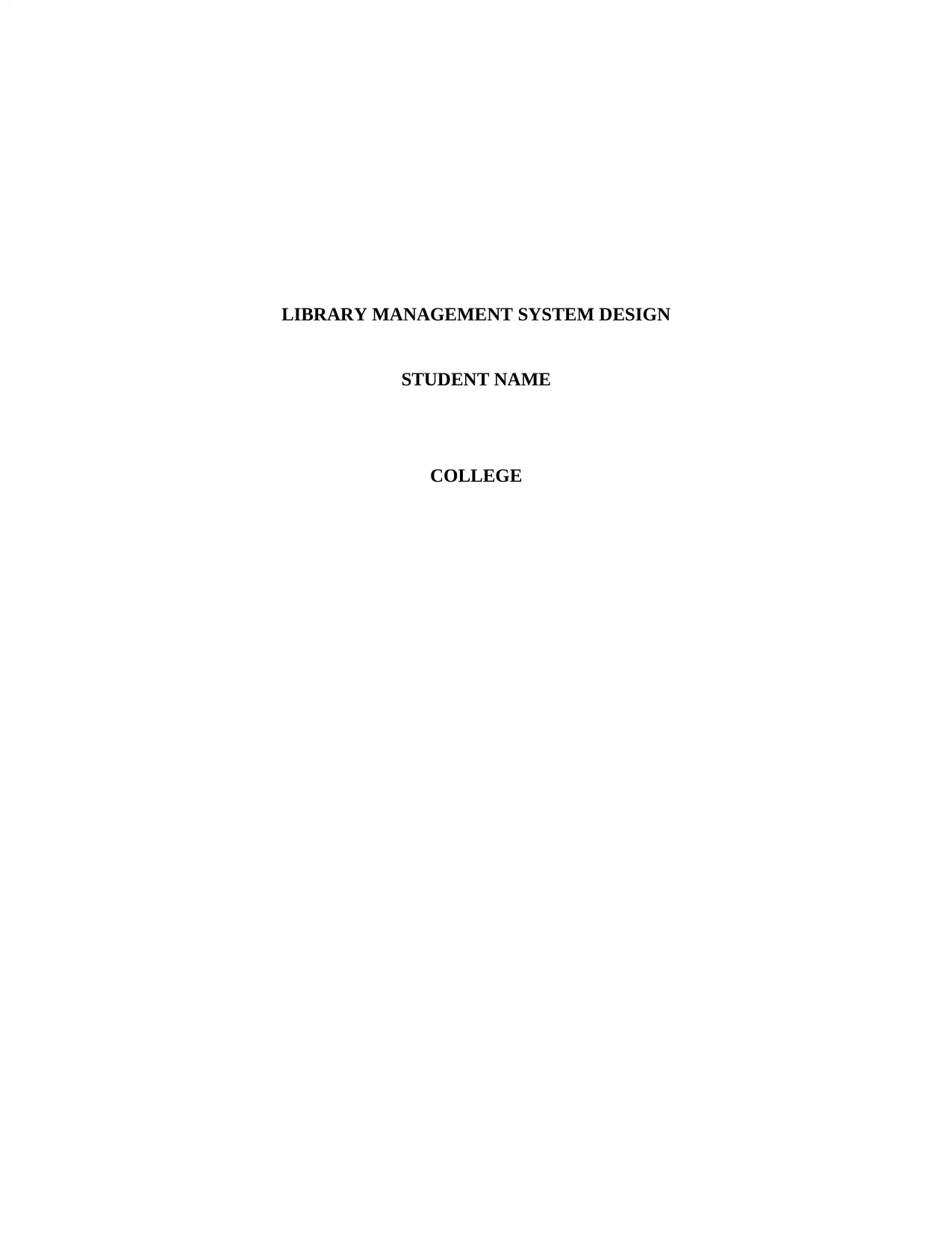
LIBRARY MANAGEMENT SYSTEM DESIGN
STUDENT NAME
COLLEGE
STUDENT NAME
COLLEGE
Secure Best Marks with AI Grader
Need help grading? Try our AI Grader for instant feedback on your assignments.
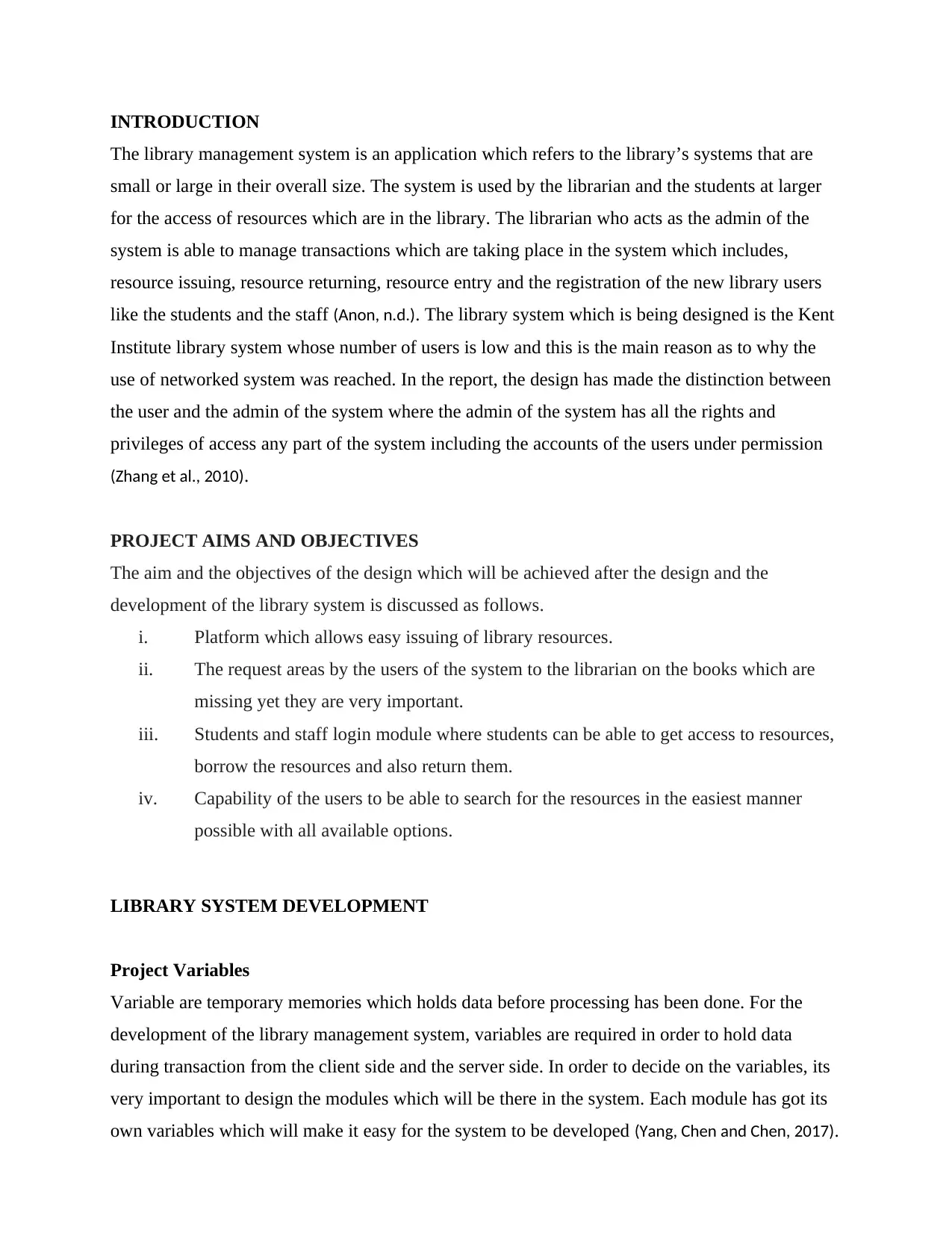
INTRODUCTION
The library management system is an application which refers to the library’s systems that are
small or large in their overall size. The system is used by the librarian and the students at larger
for the access of resources which are in the library. The librarian who acts as the admin of the
system is able to manage transactions which are taking place in the system which includes,
resource issuing, resource returning, resource entry and the registration of the new library users
like the students and the staff (Anon, n.d.). The library system which is being designed is the Kent
Institute library system whose number of users is low and this is the main reason as to why the
use of networked system was reached. In the report, the design has made the distinction between
the user and the admin of the system where the admin of the system has all the rights and
privileges of access any part of the system including the accounts of the users under permission
(Zhang et al., 2010).
PROJECT AIMS AND OBJECTIVES
The aim and the objectives of the design which will be achieved after the design and the
development of the library system is discussed as follows.
i. Platform which allows easy issuing of library resources.
ii. The request areas by the users of the system to the librarian on the books which are
missing yet they are very important.
iii. Students and staff login module where students can be able to get access to resources,
borrow the resources and also return them.
iv. Capability of the users to be able to search for the resources in the easiest manner
possible with all available options.
LIBRARY SYSTEM DEVELOPMENT
Project Variables
Variable are temporary memories which holds data before processing has been done. For the
development of the library management system, variables are required in order to hold data
during transaction from the client side and the server side. In order to decide on the variables, its
very important to design the modules which will be there in the system. Each module has got its
own variables which will make it easy for the system to be developed (Yang, Chen and Chen, 2017).
The library management system is an application which refers to the library’s systems that are
small or large in their overall size. The system is used by the librarian and the students at larger
for the access of resources which are in the library. The librarian who acts as the admin of the
system is able to manage transactions which are taking place in the system which includes,
resource issuing, resource returning, resource entry and the registration of the new library users
like the students and the staff (Anon, n.d.). The library system which is being designed is the Kent
Institute library system whose number of users is low and this is the main reason as to why the
use of networked system was reached. In the report, the design has made the distinction between
the user and the admin of the system where the admin of the system has all the rights and
privileges of access any part of the system including the accounts of the users under permission
(Zhang et al., 2010).
PROJECT AIMS AND OBJECTIVES
The aim and the objectives of the design which will be achieved after the design and the
development of the library system is discussed as follows.
i. Platform which allows easy issuing of library resources.
ii. The request areas by the users of the system to the librarian on the books which are
missing yet they are very important.
iii. Students and staff login module where students can be able to get access to resources,
borrow the resources and also return them.
iv. Capability of the users to be able to search for the resources in the easiest manner
possible with all available options.
LIBRARY SYSTEM DEVELOPMENT
Project Variables
Variable are temporary memories which holds data before processing has been done. For the
development of the library management system, variables are required in order to hold data
during transaction from the client side and the server side. In order to decide on the variables, its
very important to design the modules which will be there in the system. Each module has got its
own variables which will make it easy for the system to be developed (Yang, Chen and Chen, 2017).
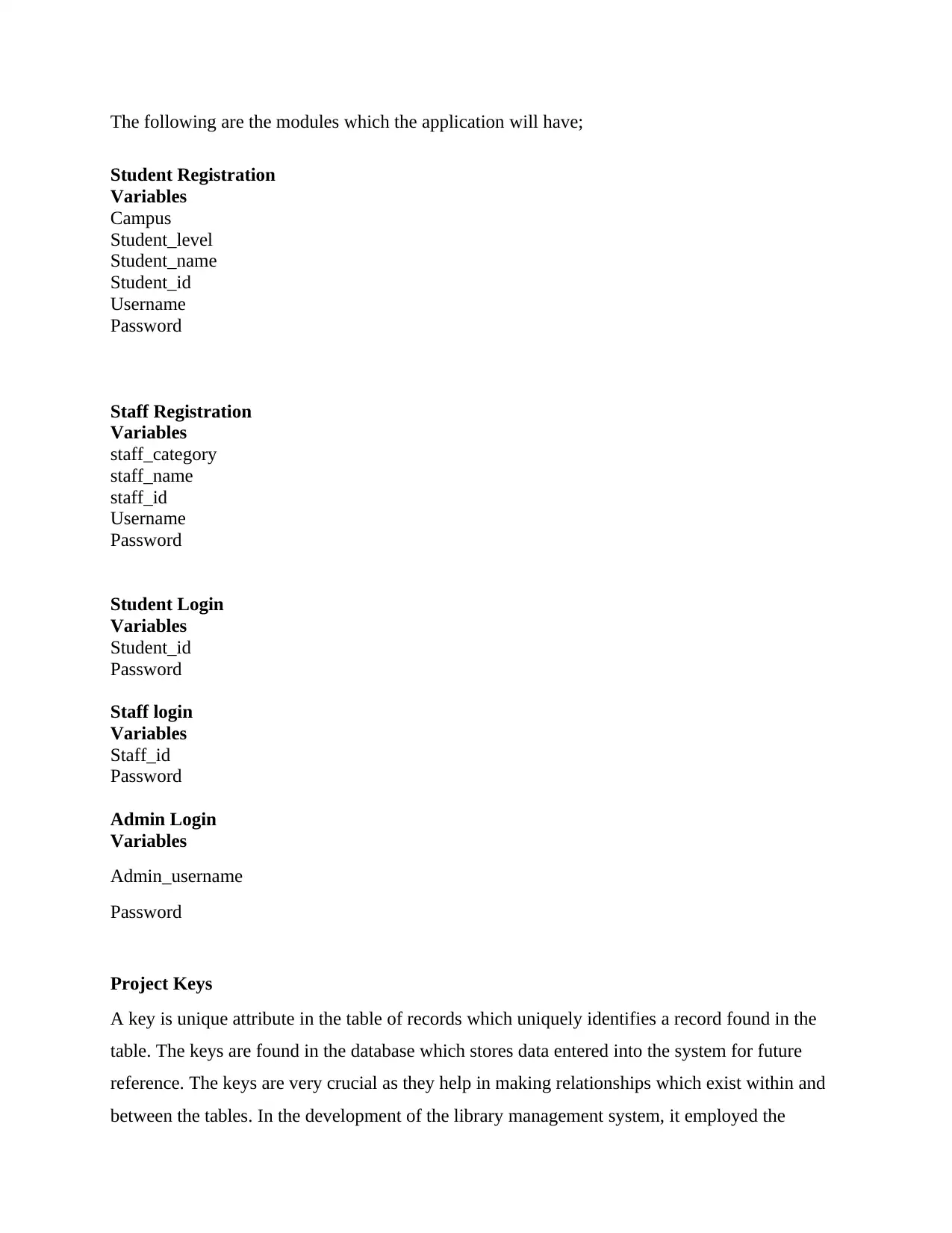
The following are the modules which the application will have;
Student Registration
Variables
Campus
Student_level
Student_name
Student_id
Username
Password
Staff Registration
Variables
staff_category
staff_name
staff_id
Username
Password
Student Login
Variables
Student_id
Password
Staff login
Variables
Staff_id
Password
Admin Login
Variables
Admin_username
Password
Project Keys
A key is unique attribute in the table of records which uniquely identifies a record found in the
table. The keys are found in the database which stores data entered into the system for future
reference. The keys are very crucial as they help in making relationships which exist within and
between the tables. In the development of the library management system, it employed the
Student Registration
Variables
Campus
Student_level
Student_name
Student_id
Username
Password
Staff Registration
Variables
staff_category
staff_name
staff_id
Username
Password
Student Login
Variables
Student_id
Password
Staff login
Variables
Staff_id
Password
Admin Login
Variables
Admin_username
Password
Project Keys
A key is unique attribute in the table of records which uniquely identifies a record found in the
table. The keys are found in the database which stores data entered into the system for future
reference. The keys are very crucial as they help in making relationships which exist within and
between the tables. In the development of the library management system, it employed the
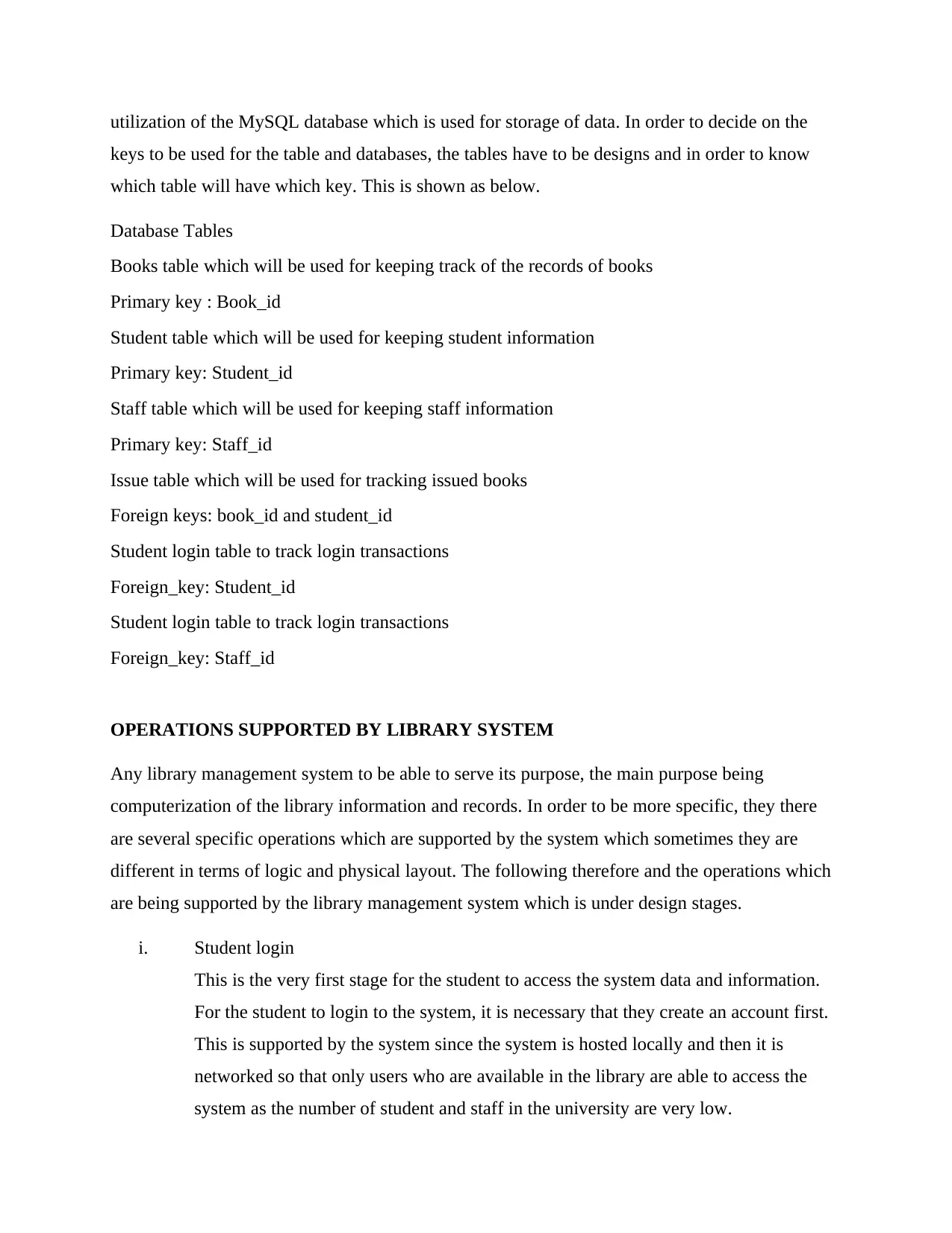
utilization of the MySQL database which is used for storage of data. In order to decide on the
keys to be used for the table and databases, the tables have to be designs and in order to know
which table will have which key. This is shown as below.
Database Tables
Books table which will be used for keeping track of the records of books
Primary key : Book_id
Student table which will be used for keeping student information
Primary key: Student_id
Staff table which will be used for keeping staff information
Primary key: Staff_id
Issue table which will be used for tracking issued books
Foreign keys: book_id and student_id
Student login table to track login transactions
Foreign_key: Student_id
Student login table to track login transactions
Foreign_key: Staff_id
OPERATIONS SUPPORTED BY LIBRARY SYSTEM
Any library management system to be able to serve its purpose, the main purpose being
computerization of the library information and records. In order to be more specific, they there
are several specific operations which are supported by the system which sometimes they are
different in terms of logic and physical layout. The following therefore and the operations which
are being supported by the library management system which is under design stages.
i. Student login
This is the very first stage for the student to access the system data and information.
For the student to login to the system, it is necessary that they create an account first.
This is supported by the system since the system is hosted locally and then it is
networked so that only users who are available in the library are able to access the
system as the number of student and staff in the university are very low.
keys to be used for the table and databases, the tables have to be designs and in order to know
which table will have which key. This is shown as below.
Database Tables
Books table which will be used for keeping track of the records of books
Primary key : Book_id
Student table which will be used for keeping student information
Primary key: Student_id
Staff table which will be used for keeping staff information
Primary key: Staff_id
Issue table which will be used for tracking issued books
Foreign keys: book_id and student_id
Student login table to track login transactions
Foreign_key: Student_id
Student login table to track login transactions
Foreign_key: Staff_id
OPERATIONS SUPPORTED BY LIBRARY SYSTEM
Any library management system to be able to serve its purpose, the main purpose being
computerization of the library information and records. In order to be more specific, they there
are several specific operations which are supported by the system which sometimes they are
different in terms of logic and physical layout. The following therefore and the operations which
are being supported by the library management system which is under design stages.
i. Student login
This is the very first stage for the student to access the system data and information.
For the student to login to the system, it is necessary that they create an account first.
This is supported by the system since the system is hosted locally and then it is
networked so that only users who are available in the library are able to access the
system as the number of student and staff in the university are very low.
Secure Best Marks with AI Grader
Need help grading? Try our AI Grader for instant feedback on your assignments.
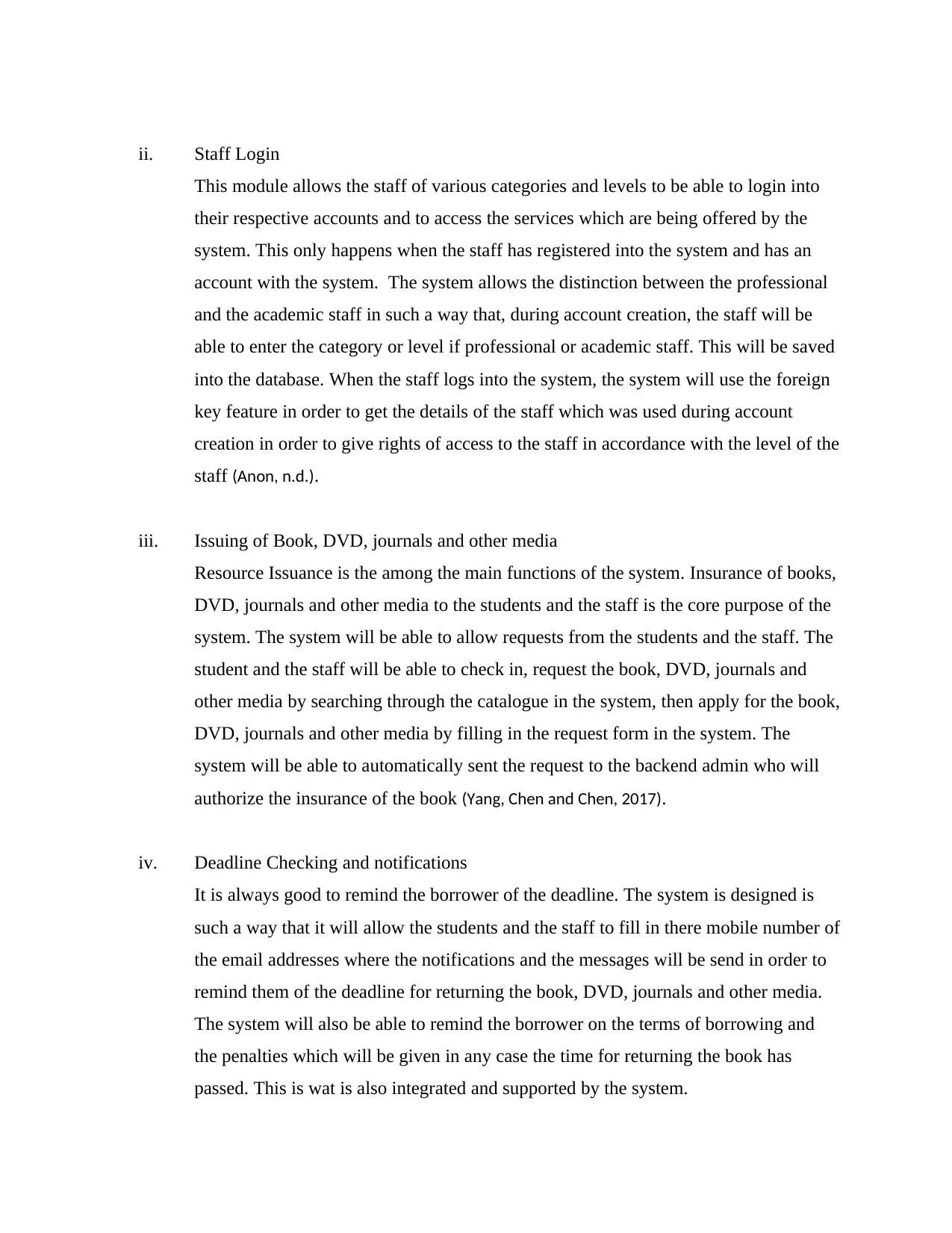
ii. Staff Login
This module allows the staff of various categories and levels to be able to login into
their respective accounts and to access the services which are being offered by the
system. This only happens when the staff has registered into the system and has an
account with the system. The system allows the distinction between the professional
and the academic staff in such a way that, during account creation, the staff will be
able to enter the category or level if professional or academic staff. This will be saved
into the database. When the staff logs into the system, the system will use the foreign
key feature in order to get the details of the staff which was used during account
creation in order to give rights of access to the staff in accordance with the level of the
staff (Anon, n.d.).
iii. Issuing of Book, DVD, journals and other media
Resource Issuance is the among the main functions of the system. Insurance of books,
DVD, journals and other media to the students and the staff is the core purpose of the
system. The system will be able to allow requests from the students and the staff. The
student and the staff will be able to check in, request the book, DVD, journals and
other media by searching through the catalogue in the system, then apply for the book,
DVD, journals and other media by filling in the request form in the system. The
system will be able to automatically sent the request to the backend admin who will
authorize the insurance of the book (Yang, Chen and Chen, 2017).
iv. Deadline Checking and notifications
It is always good to remind the borrower of the deadline. The system is designed is
such a way that it will allow the students and the staff to fill in there mobile number of
the email addresses where the notifications and the messages will be send in order to
remind them of the deadline for returning the book, DVD, journals and other media.
The system will also be able to remind the borrower on the terms of borrowing and
the penalties which will be given in any case the time for returning the book has
passed. This is wat is also integrated and supported by the system.
This module allows the staff of various categories and levels to be able to login into
their respective accounts and to access the services which are being offered by the
system. This only happens when the staff has registered into the system and has an
account with the system. The system allows the distinction between the professional
and the academic staff in such a way that, during account creation, the staff will be
able to enter the category or level if professional or academic staff. This will be saved
into the database. When the staff logs into the system, the system will use the foreign
key feature in order to get the details of the staff which was used during account
creation in order to give rights of access to the staff in accordance with the level of the
staff (Anon, n.d.).
iii. Issuing of Book, DVD, journals and other media
Resource Issuance is the among the main functions of the system. Insurance of books,
DVD, journals and other media to the students and the staff is the core purpose of the
system. The system will be able to allow requests from the students and the staff. The
student and the staff will be able to check in, request the book, DVD, journals and
other media by searching through the catalogue in the system, then apply for the book,
DVD, journals and other media by filling in the request form in the system. The
system will be able to automatically sent the request to the backend admin who will
authorize the insurance of the book (Yang, Chen and Chen, 2017).
iv. Deadline Checking and notifications
It is always good to remind the borrower of the deadline. The system is designed is
such a way that it will allow the students and the staff to fill in there mobile number of
the email addresses where the notifications and the messages will be send in order to
remind them of the deadline for returning the book, DVD, journals and other media.
The system will also be able to remind the borrower on the terms of borrowing and
the penalties which will be given in any case the time for returning the book has
passed. This is wat is also integrated and supported by the system.
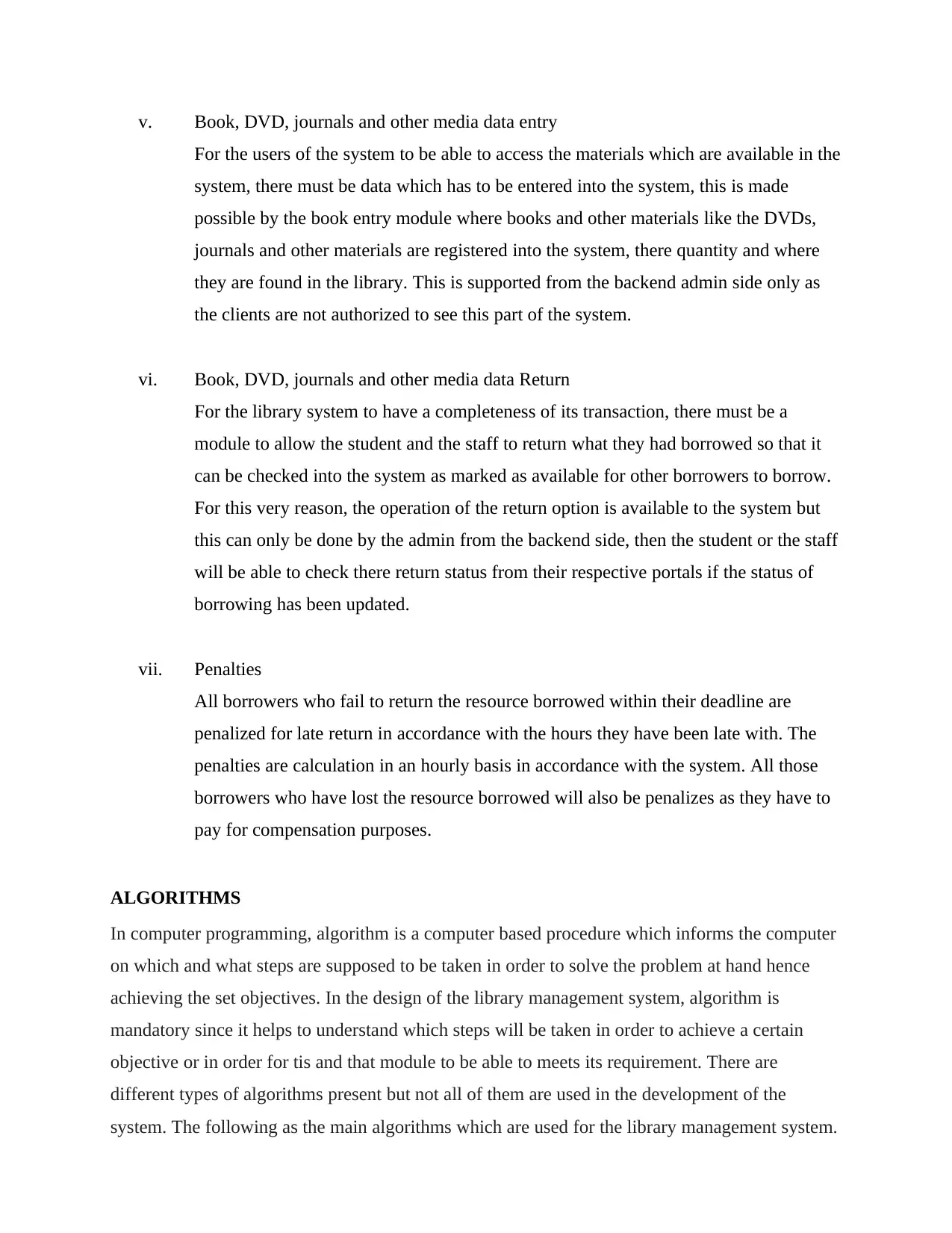
v. Book, DVD, journals and other media data entry
For the users of the system to be able to access the materials which are available in the
system, there must be data which has to be entered into the system, this is made
possible by the book entry module where books and other materials like the DVDs,
journals and other materials are registered into the system, there quantity and where
they are found in the library. This is supported from the backend admin side only as
the clients are not authorized to see this part of the system.
vi. Book, DVD, journals and other media data Return
For the library system to have a completeness of its transaction, there must be a
module to allow the student and the staff to return what they had borrowed so that it
can be checked into the system as marked as available for other borrowers to borrow.
For this very reason, the operation of the return option is available to the system but
this can only be done by the admin from the backend side, then the student or the staff
will be able to check there return status from their respective portals if the status of
borrowing has been updated.
vii. Penalties
All borrowers who fail to return the resource borrowed within their deadline are
penalized for late return in accordance with the hours they have been late with. The
penalties are calculation in an hourly basis in accordance with the system. All those
borrowers who have lost the resource borrowed will also be penalizes as they have to
pay for compensation purposes.
ALGORITHMS
In computer programming, algorithm is a computer based procedure which informs the computer
on which and what steps are supposed to be taken in order to solve the problem at hand hence
achieving the set objectives. In the design of the library management system, algorithm is
mandatory since it helps to understand which steps will be taken in order to achieve a certain
objective or in order for tis and that module to be able to meets its requirement. There are
different types of algorithms present but not all of them are used in the development of the
system. The following as the main algorithms which are used for the library management system.
For the users of the system to be able to access the materials which are available in the
system, there must be data which has to be entered into the system, this is made
possible by the book entry module where books and other materials like the DVDs,
journals and other materials are registered into the system, there quantity and where
they are found in the library. This is supported from the backend admin side only as
the clients are not authorized to see this part of the system.
vi. Book, DVD, journals and other media data Return
For the library system to have a completeness of its transaction, there must be a
module to allow the student and the staff to return what they had borrowed so that it
can be checked into the system as marked as available for other borrowers to borrow.
For this very reason, the operation of the return option is available to the system but
this can only be done by the admin from the backend side, then the student or the staff
will be able to check there return status from their respective portals if the status of
borrowing has been updated.
vii. Penalties
All borrowers who fail to return the resource borrowed within their deadline are
penalized for late return in accordance with the hours they have been late with. The
penalties are calculation in an hourly basis in accordance with the system. All those
borrowers who have lost the resource borrowed will also be penalizes as they have to
pay for compensation purposes.
ALGORITHMS
In computer programming, algorithm is a computer based procedure which informs the computer
on which and what steps are supposed to be taken in order to solve the problem at hand hence
achieving the set objectives. In the design of the library management system, algorithm is
mandatory since it helps to understand which steps will be taken in order to achieve a certain
objective or in order for tis and that module to be able to meets its requirement. There are
different types of algorithms present but not all of them are used in the development of the
system. The following as the main algorithms which are used for the library management system.
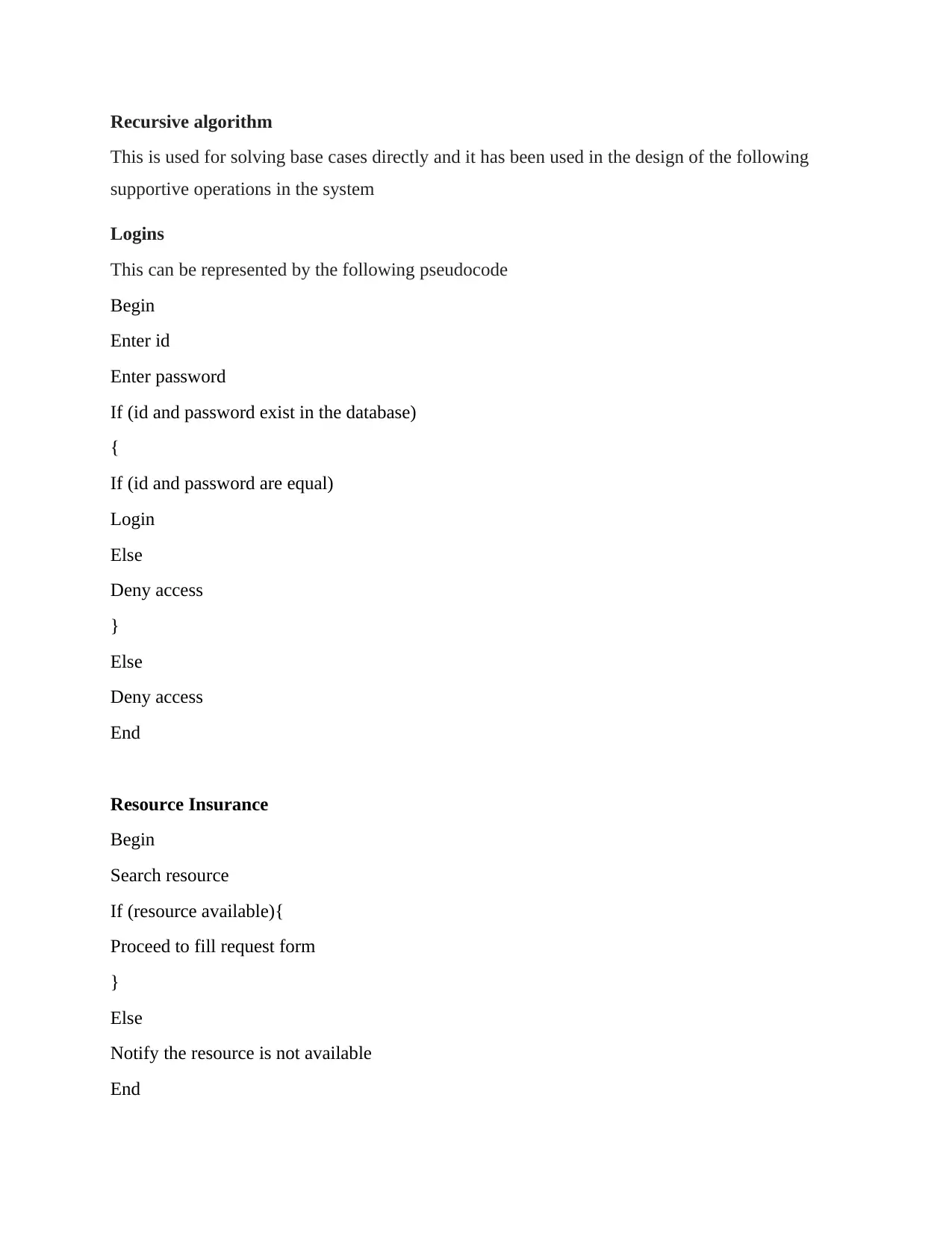
Recursive algorithm
This is used for solving base cases directly and it has been used in the design of the following
supportive operations in the system
Logins
This can be represented by the following pseudocode
Begin
Enter id
Enter password
If (id and password exist in the database)
{
If (id and password are equal)
Login
Else
Deny access
}
Else
Deny access
End
Resource Insurance
Begin
Search resource
If (resource available){
Proceed to fill request form
}
Else
Notify the resource is not available
End
This is used for solving base cases directly and it has been used in the design of the following
supportive operations in the system
Logins
This can be represented by the following pseudocode
Begin
Enter id
Enter password
If (id and password exist in the database)
{
If (id and password are equal)
Login
Else
Deny access
}
Else
Deny access
End
Resource Insurance
Begin
Search resource
If (resource available){
Proceed to fill request form
}
Else
Notify the resource is not available
End
Paraphrase This Document
Need a fresh take? Get an instant paraphrase of this document with our AI Paraphraser
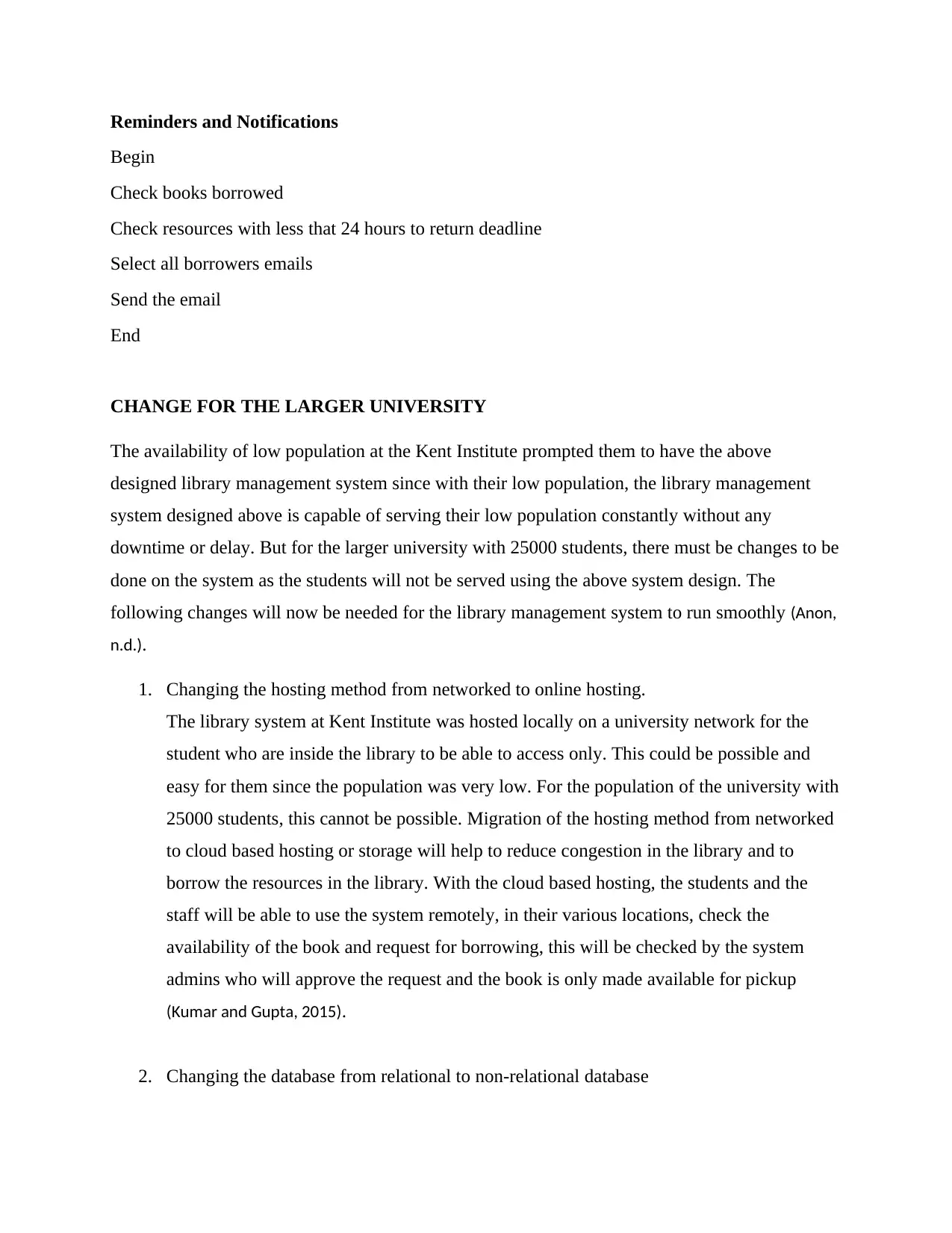
Reminders and Notifications
Begin
Check books borrowed
Check resources with less that 24 hours to return deadline
Select all borrowers emails
Send the email
End
CHANGE FOR THE LARGER UNIVERSITY
The availability of low population at the Kent Institute prompted them to have the above
designed library management system since with their low population, the library management
system designed above is capable of serving their low population constantly without any
downtime or delay. But for the larger university with 25000 students, there must be changes to be
done on the system as the students will not be served using the above system design. The
following changes will now be needed for the library management system to run smoothly (Anon,
n.d.).
1. Changing the hosting method from networked to online hosting.
The library system at Kent Institute was hosted locally on a university network for the
student who are inside the library to be able to access only. This could be possible and
easy for them since the population was very low. For the population of the university with
25000 students, this cannot be possible. Migration of the hosting method from networked
to cloud based hosting or storage will help to reduce congestion in the library and to
borrow the resources in the library. With the cloud based hosting, the students and the
staff will be able to use the system remotely, in their various locations, check the
availability of the book and request for borrowing, this will be checked by the system
admins who will approve the request and the book is only made available for pickup
(Kumar and Gupta, 2015).
2. Changing the database from relational to non-relational database
Begin
Check books borrowed
Check resources with less that 24 hours to return deadline
Select all borrowers emails
Send the email
End
CHANGE FOR THE LARGER UNIVERSITY
The availability of low population at the Kent Institute prompted them to have the above
designed library management system since with their low population, the library management
system designed above is capable of serving their low population constantly without any
downtime or delay. But for the larger university with 25000 students, there must be changes to be
done on the system as the students will not be served using the above system design. The
following changes will now be needed for the library management system to run smoothly (Anon,
n.d.).
1. Changing the hosting method from networked to online hosting.
The library system at Kent Institute was hosted locally on a university network for the
student who are inside the library to be able to access only. This could be possible and
easy for them since the population was very low. For the population of the university with
25000 students, this cannot be possible. Migration of the hosting method from networked
to cloud based hosting or storage will help to reduce congestion in the library and to
borrow the resources in the library. With the cloud based hosting, the students and the
staff will be able to use the system remotely, in their various locations, check the
availability of the book and request for borrowing, this will be checked by the system
admins who will approve the request and the book is only made available for pickup
(Kumar and Gupta, 2015).
2. Changing the database from relational to non-relational database
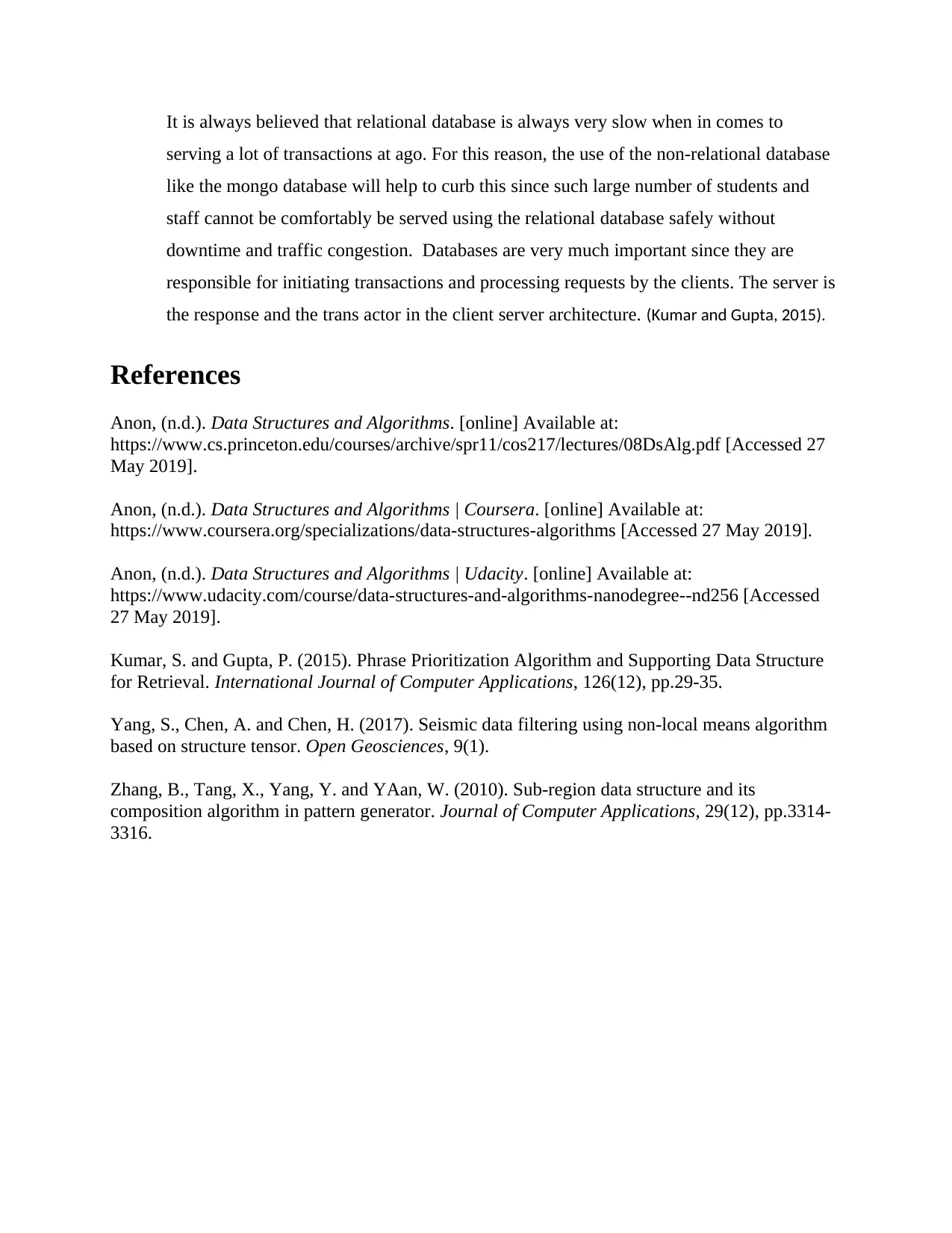
It is always believed that relational database is always very slow when in comes to
serving a lot of transactions at ago. For this reason, the use of the non-relational database
like the mongo database will help to curb this since such large number of students and
staff cannot be comfortably be served using the relational database safely without
downtime and traffic congestion. Databases are very much important since they are
responsible for initiating transactions and processing requests by the clients. The server is
the response and the trans actor in the client server architecture. (Kumar and Gupta, 2015).
References
Anon, (n.d.). Data Structures and Algorithms. [online] Available at:
https://www.cs.princeton.edu/courses/archive/spr11/cos217/lectures/08DsAlg.pdf [Accessed 27
May 2019].
Anon, (n.d.). Data Structures and Algorithms | Coursera. [online] Available at:
https://www.coursera.org/specializations/data-structures-algorithms [Accessed 27 May 2019].
Anon, (n.d.). Data Structures and Algorithms | Udacity. [online] Available at:
https://www.udacity.com/course/data-structures-and-algorithms-nanodegree--nd256 [Accessed
27 May 2019].
Kumar, S. and Gupta, P. (2015). Phrase Prioritization Algorithm and Supporting Data Structure
for Retrieval. International Journal of Computer Applications, 126(12), pp.29-35.
Yang, S., Chen, A. and Chen, H. (2017). Seismic data filtering using non-local means algorithm
based on structure tensor. Open Geosciences, 9(1).
Zhang, B., Tang, X., Yang, Y. and YAan, W. (2010). Sub-region data structure and its
composition algorithm in pattern generator. Journal of Computer Applications, 29(12), pp.3314-
3316.
serving a lot of transactions at ago. For this reason, the use of the non-relational database
like the mongo database will help to curb this since such large number of students and
staff cannot be comfortably be served using the relational database safely without
downtime and traffic congestion. Databases are very much important since they are
responsible for initiating transactions and processing requests by the clients. The server is
the response and the trans actor in the client server architecture. (Kumar and Gupta, 2015).
References
Anon, (n.d.). Data Structures and Algorithms. [online] Available at:
https://www.cs.princeton.edu/courses/archive/spr11/cos217/lectures/08DsAlg.pdf [Accessed 27
May 2019].
Anon, (n.d.). Data Structures and Algorithms | Coursera. [online] Available at:
https://www.coursera.org/specializations/data-structures-algorithms [Accessed 27 May 2019].
Anon, (n.d.). Data Structures and Algorithms | Udacity. [online] Available at:
https://www.udacity.com/course/data-structures-and-algorithms-nanodegree--nd256 [Accessed
27 May 2019].
Kumar, S. and Gupta, P. (2015). Phrase Prioritization Algorithm and Supporting Data Structure
for Retrieval. International Journal of Computer Applications, 126(12), pp.29-35.
Yang, S., Chen, A. and Chen, H. (2017). Seismic data filtering using non-local means algorithm
based on structure tensor. Open Geosciences, 9(1).
Zhang, B., Tang, X., Yang, Y. and YAan, W. (2010). Sub-region data structure and its
composition algorithm in pattern generator. Journal of Computer Applications, 29(12), pp.3314-
3316.
1 out of 9
Related Documents
Your All-in-One AI-Powered Toolkit for Academic Success.
+13062052269
info@desklib.com
Available 24*7 on WhatsApp / Email
![[object Object]](/_next/static/media/star-bottom.7253800d.svg)
Unlock your academic potential
© 2024 | Zucol Services PVT LTD | All rights reserved.





